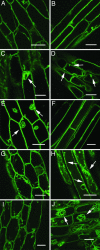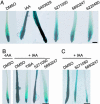The power of chemical genomics to study the link between endomembrane system components and the gravitropic response
- PMID: 15772170
- PMCID: PMC555711
- DOI: 10.1073/pnas.0500222102
The power of chemical genomics to study the link between endomembrane system components and the gravitropic response
Erratum in
- Proc Natl Acad Sci U S A. 2005 Jul 26;102(30):10752
Abstract
Chemical genomics is a powerful approach to dissect processes that may be intractable using conventional genetics because of gene lethality or redundancy. Recently, a link has been established between endomembrane trafficking and gravitropism. To understand this link, we screened a library of 10,000 diverse chemicals for compounds that affected the gravitropism of Arabidopsis seedlings positively or negatively. Sixty-nine of 219 compounds from the primary screen were retested, and 34 of these were confirmed to inhibit or enhance gravitropism. Four of the 34 compounds were found to cause aberrant endomembrane morphologies. The chemicals affected gravitropism and vacuole morphology in concert in a tissue-specific manner, underscoring the link between endomembranes and gravitropism. One of the chemicals (5403629) was structurally similar to the synthetic auxin 2,4-dichlorophenoxy acetate, whereas the other three chemicals were unique in their structures. An in vivo functional assay using the reporter beta-glucuronidase under the auxin-inducible DR5 promoter confirmed that the unique compounds were not auxins. Interestingly, one of the unique chemicals (5850247) appeared to decrease the responsiveness to auxin in roots, whereas another (5271050) was similar to pyocyanin, a bacterial metabolite that has been suggested to target the endomembranes of yeast. These reagents will be valuable for dissecting endomembrane trafficking and gravitropism and for cognate target identification.
Figures




Similar articles
-
The use of chemical genomics to investigate pathways intersecting auxin-dependent responses and endomembrane trafficking in Arabidopsis thaliana.Methods Mol Biol. 2009;495:133-43. doi: 10.1007/978-1-59745-477-3_12. Methods Mol Biol. 2009. PMID: 19085151
-
Abscisic acid is a negative regulator of root gravitropism in Arabidopsis thaliana.Biochem Biophys Res Commun. 2009 Jan 23;378(4):695-700. doi: 10.1016/j.bbrc.2008.11.080. Epub 2008 Dec 3. Biochem Biophys Res Commun. 2009. PMID: 19056344
-
Extracellular ATP inhibits root gravitropism at concentrations that inhibit polar auxin transport.Plant Physiol. 2003 Jan;131(1):147-54. doi: 10.1104/pp.013672. Plant Physiol. 2003. PMID: 12529523 Free PMC article.
-
Molecular genetic analysis of plant gravitropism.Gravit Space Biol Bull. 1997 Jun;10(2):75-82. Gravit Space Biol Bull. 1997. PMID: 11540123 Review.
-
Auxin regulated gene expression and gravitropism in plants.ASGSB Bull. 1995 Oct;8(2):39-45. ASGSB Bull. 1995. PMID: 11538549 Review.
Cited by
-
Powerful partners: Arabidopsis and chemical genomics.Arabidopsis Book. 2009;7:e0109. doi: 10.1199/tab.0109. Epub 2009 Jan 21. Arabidopsis Book. 2009. PMID: 22303245 Free PMC article.
-
Bestatin, an inhibitor of aminopeptidases, provides a chemical genetics approach to dissect jasmonate signaling in Arabidopsis.Plant Physiol. 2006 Aug;141(4):1400-13. doi: 10.1104/pp.106.080390. Epub 2006 Jun 23. Plant Physiol. 2006. PMID: 16798948 Free PMC article.
-
Polar delivery in plants; commonalities and differences to animal epithelial cells.Open Biol. 2014 Apr 16;4(4):140017. doi: 10.1098/rsob.140017. Open Biol. 2014. PMID: 24740985 Free PMC article. Review.
-
A cellulose synthesis inhibitor affects cellulose synthase complex secretion and cortical microtubule dynamics.Plant Physiol. 2024 Sep 2;196(1):124-136. doi: 10.1093/plphys/kiae232. Plant Physiol. 2024. PMID: 38833284 Free PMC article.
-
Genetic characterization of mutants resistant to the antiauxin p-chlorophenoxyisobutyric acid reveals that AAR3, a gene encoding a DCN1-like protein, regulates responses to the synthetic auxin 2,4-dichlorophenoxyacetic acid in Arabidopsis roots.Plant Physiol. 2007 Nov;145(3):773-85. doi: 10.1104/pp.107.104844. Epub 2007 Sep 28. Plant Physiol. 2007. PMID: 17905859 Free PMC article.
References
-
- Sanderfoot, A. A. & Raikhel, N. V. (2003) The Arabidopsis Book, eds. Somerville, C. R. & Meyerowitz, E. M. (American Society of Plant Biologists, Rockville, MD).
-
- Rojo, E., Gillmor, C. S., Kovaleva, V., Somerville, C. R. & Raikhel, N. V. (2001) Dev. Cell 1, 303-310. - PubMed
-
- Surpin, M. & Raikhel, N. (2004) Nat. Rev. Mol. Cell Biol. 5, 100-109. - PubMed
Publication types
MeSH terms
Substances
LinkOut - more resources
Full Text Sources
Other Literature Sources

